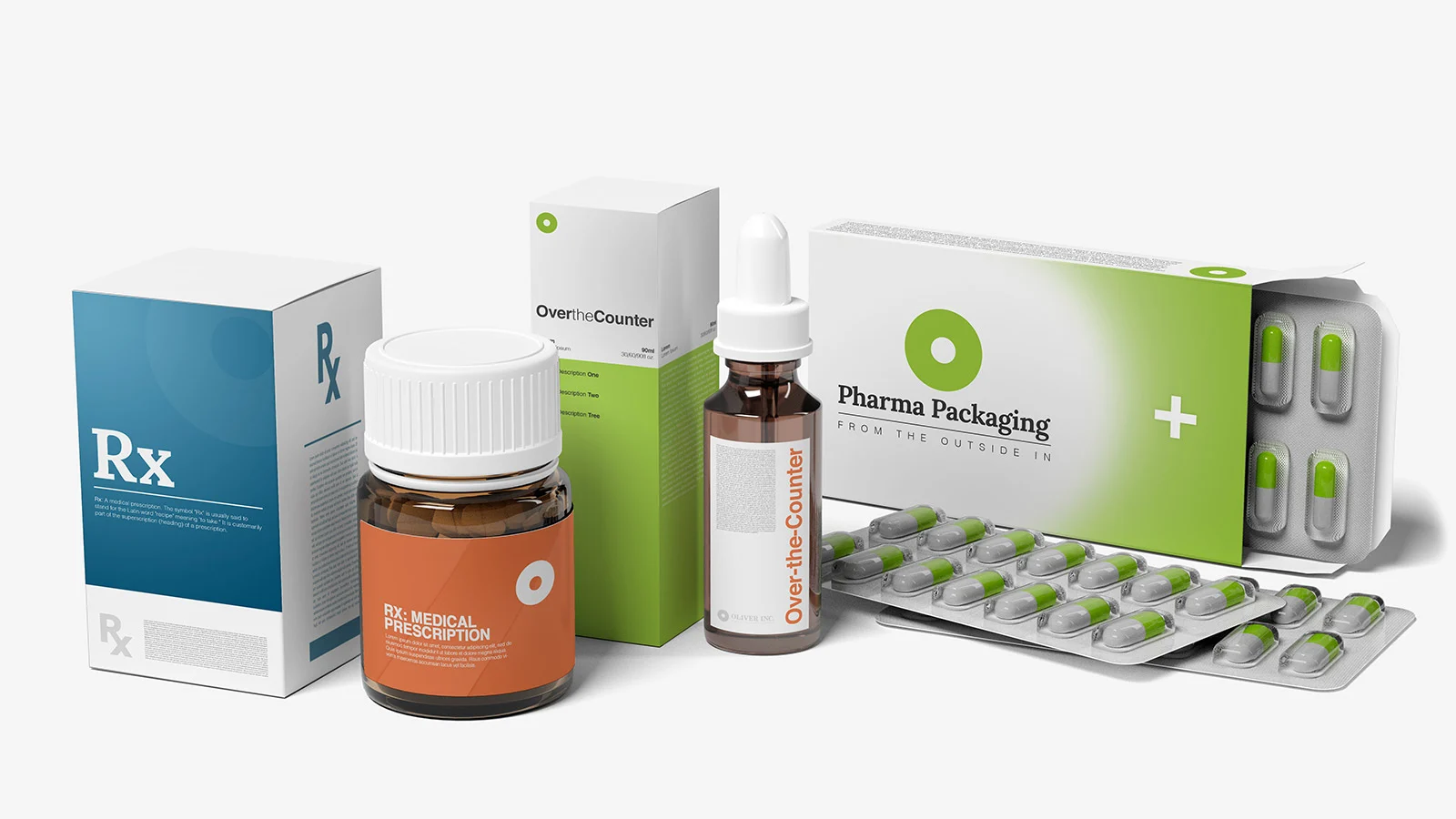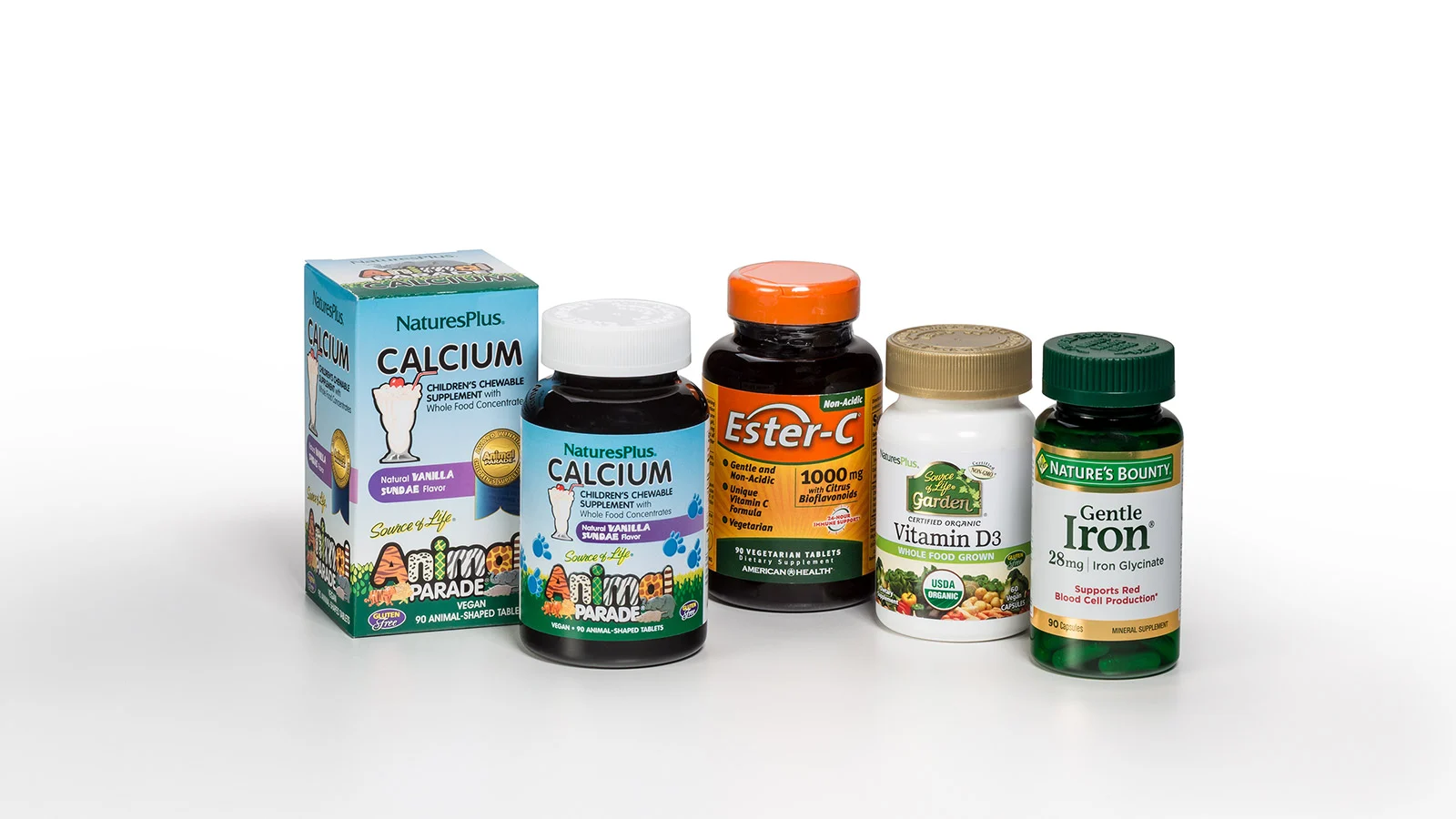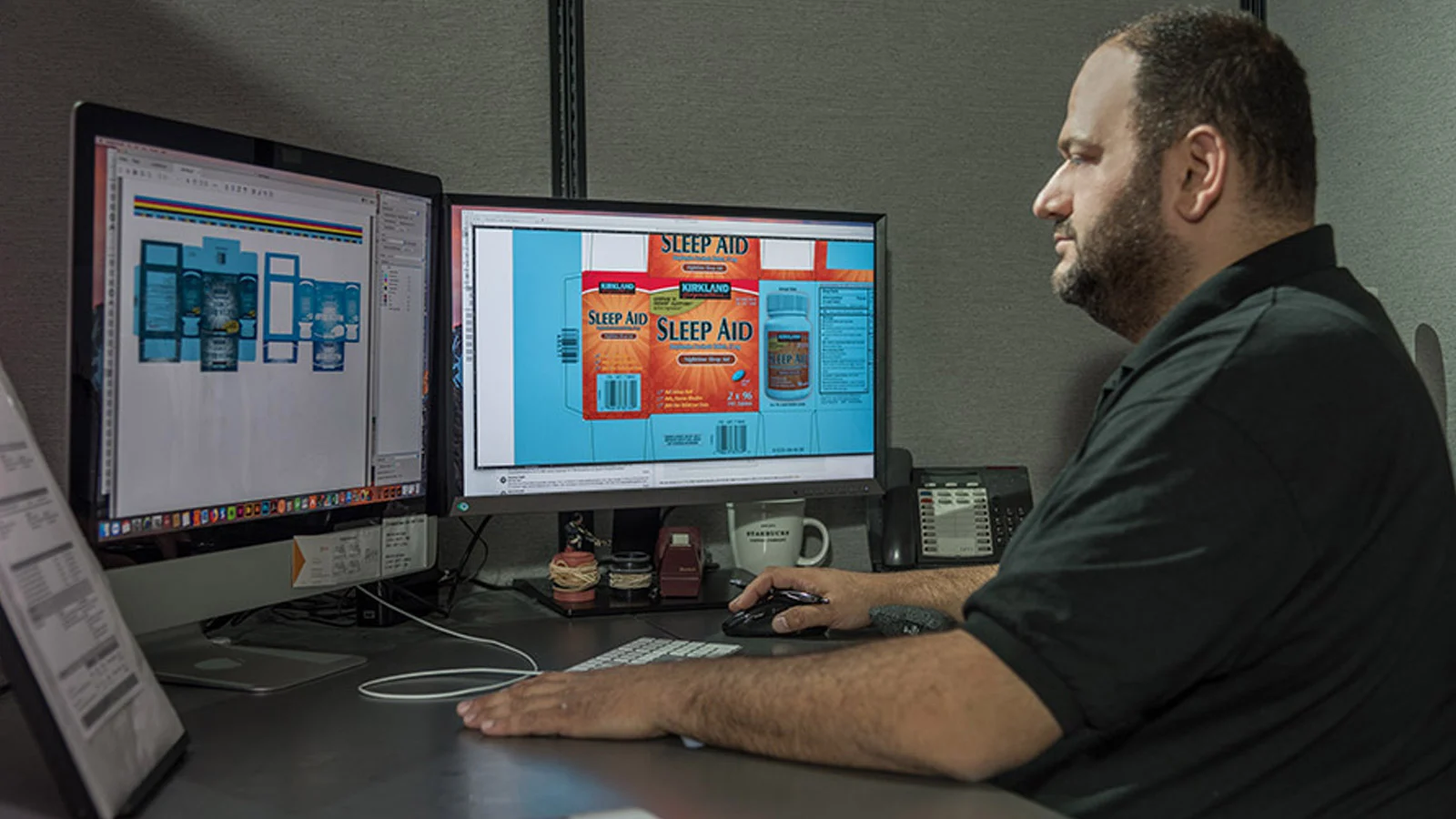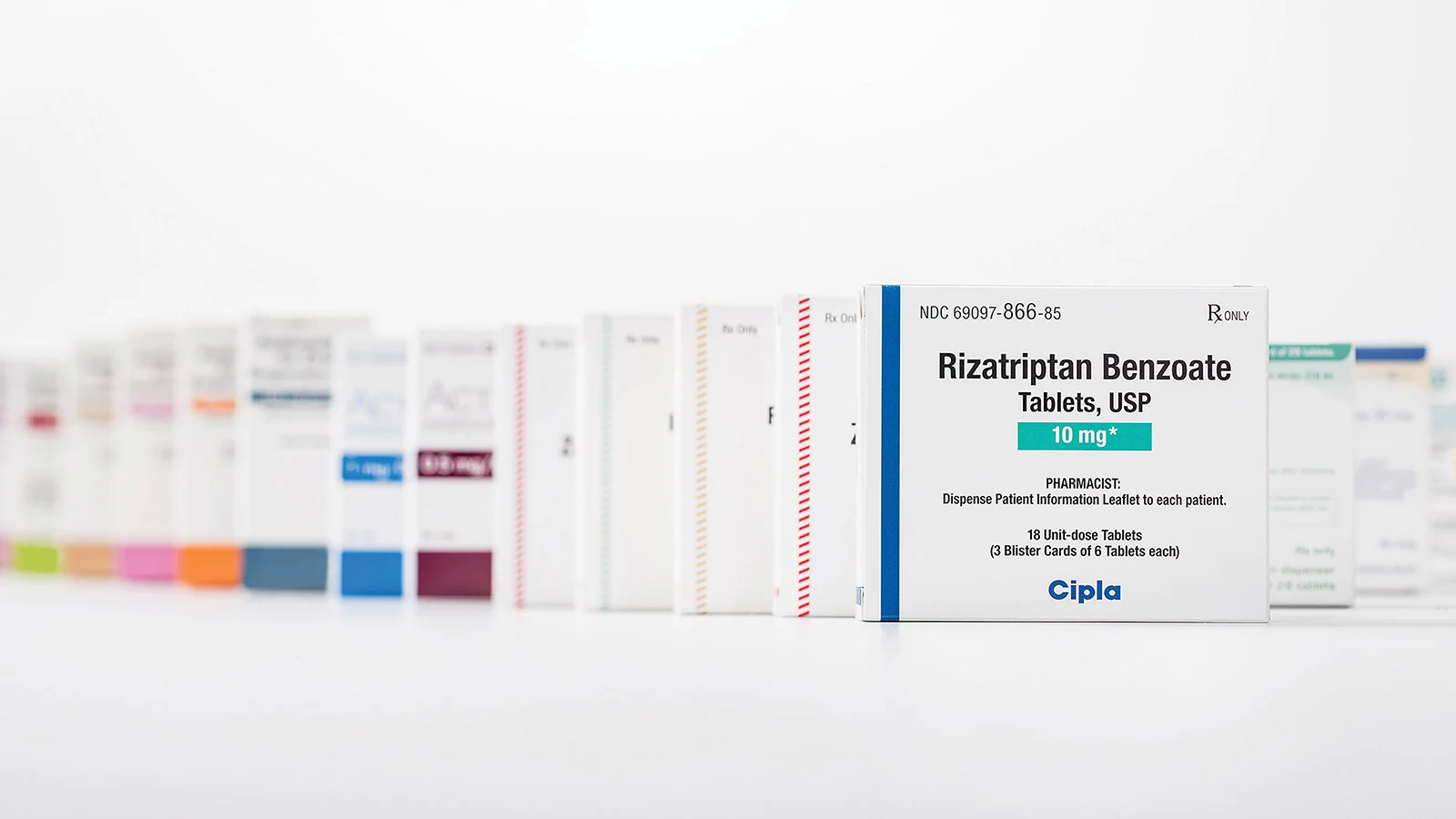Pharmaceutical Packaging Solutions

Introduction
When a previously prescription-only product becomes available over the counter, what happens to the paperwork that used to go along with it? After all, it contained information on proper use, warnings, and ingredients that remains relevant to consumers even if they can now find the medicine themselves in a drug store.
The short answer is that the information is still there. It’s just presented in different ways: on the folding carton holding the product, on the extended content label that peels off the packaging, and on inserts.
All are parts of pharmaceutical packaging, but so much more goes into it. We’re here to tell you about it.

The Importance of Primary & Secondary Packaging for Pharmaceuticals
Pharmaceuticals isn’t the only industry where packaging plays a significant role in protecting consumers. The same could be said for food and beverages, as well as cosmetics, where ingredients and expiration dates provide crucial information.
When it comes to health, though, there’s an extra level of importance. Consumers expect to know exactly what they’re putting into their bodies and the products’ intended effects. They trust when they walk the aisles of a pharmacy, they’re only seeing safe options.
Pharma companies need packaging that achieves the following:
- Informs Consumers
- Attracts Customers
- Protects Products
These apply both to primary and secondary packaging.
Primary & Secondary Packaging
Primary packaging is the first layer of protection for products, and the last layer of packaging the consumer opens. Secondary packaging hosts individual units of the product. It’s often a folding carton.
For instance, the bottle of aspirin is the primary packaging. The box it comes in is the secondary packaging.
Now, imagine consumer behavior. After they purchase the aspirin (or pain reliever, etc.), they often discard the box. That means information about proper use, storage, dosage, warnings, and active ingredients must be on both the primary and secondary packaging. A strong label makes a difference here, as well.
Consider that many over-the-counter medications and pharma products are kept in bathrooms. The labels need to hold up against humidity to avoid peeling or fading that may compromise the safety of the consumer.
Finally, there’s another level of protection: Anticounterfeiting. Both primary and secondary packaging should include covert (those you can’t see) or overt (those you can) solutions to protect your brand and consumers. Labels could include holographic features, difficult to replicate. Folding cartons could have tamper-evident closures.
It’s about building trust with consumers while elevating your brand. By considering all aspects of your primary and secondary packaging, you can do just that.

Pharmaceutical Packaging & Label Trends
The most promising trends in pharmaceutical packaging and labeling center around anti-counterfeiting technologies, eye-grabbing decorative effects, sustainability, and extended gamut printing. Let’s unbox each of these.
Anti-Counterfeit Technologies
Criminal commerce is peddling illegitimate pharmaceutical products using counterfeit packaging and labeling. This has been made easier through the proliferation of sales channels available through e-commerce. It’s difficult for consumers to distinguish between knock-off items and authorized pharmaceuticals, especially when counterfeit products are shipped in generic boxes and packaging. This threatens consumer safety. Plus, it corrodes trust in pharmaceutical brands among consumers unwittingly using substandard products.
To counteract this, overt and covert anti-counterfeiting technologies are becoming common practice.
Overt authentication solutions can range from color-shifting inks that change color when viewed from a particular angle and holographic seals and labels that feature sophisticated graphics difficult to reproduce without high-end technology to tamper-evident closures and labels informing retailers and manufacturers whether pharmaceutical packaging has already been opened.
Covert authentication solutions are concealed from unassisted vision. These include thermochromic inks that reveal hidden images when they experience severe temperature changes, hidden indicia design features only seen through special decoding lenses, and digimarc barcodes and digital watermarking made visible with specially tailored devices.
It’s important these anti-counterfeiting features fuse well with compelling decorative elements.
Decorative Effects
Part of what enables packaging to add so much value to your products resides in its decorative traits. Pharmaceutical brands are utilizing coating and laminates, hot foil stamping, and cold foil. Let’s polish up your knowledge of each.
Coating and laminates provide shine as well as abrasion resistance to packaging— from gloss coatings’ elegant shimmering effect and strike-through and reticulating varnish’s unrivaled rub resistance and glimmer to tactile coatings that give consumers additional sensory experience.
Hot foil stamping relies on a heating technique to attach foil to a substrate, creating a metallic sheen.
Cold foil depends on ultraviolet light to produce metallic colors within the four-color CMYK and PMS spectrums.
In addition to attention-grabbing decorative effects, pharmaceutical brands are stepping up their sustainability efforts.
Sustainable Pharmaceutical Packaging
Sustainability in packaging and labeling has become front and center for industry- leading companies, in response to increasing customer demand. In simple terms, sustainable packaging means using the minimal amount of materials needed to secure and protect your product. In concrete terms, this involves practicing right-size packaging principles, minimizing your carbon footprint, and utilizing tree-free alternative substrates.
Right-size packaging entails utilizing only the materials you need, avoiding bulky packaging with underutilized air pockets or unnecessary layers.
Minimizing your carbon footprint comprises not just turning to more sustainable energy sources throughout production, but relying on sustainably sourced materials, as verified by nonprofit Forest Stewardship Council (FSC), Sustainable Forest Initiative (SFI), or Programme for the Endorsement of Forest Certification (PEFC)
Utilizing tree-free alternatives includes moving away from petroleum-based products (plastics) when appropriate, and paper, toward substrates such as sugarcane board, recycled cotton fibers, and hemp. In addition to biodegradables, pharmaceutical brands are incorporating green messaging into their labels, such as “produced by 100% post-consumer recycled materials.”
Sustainability is likely to only grow more prominent in pharmaceutical packaging, but so are the color possibilities with extended gamut printing.
Extended Gamut Printing for Pharmaceuticals
While national pharmaceutical brands dominate many markets, regional retailers are turning to printers capable of extended gamut printing (EG) to help grow their market share. Going beyond the traditional four-color process (CMYK), EG is a major cost-saver, enabling manufacturers to print cartons for different products simultaneously on combination runs.

Private Labels & Extended Gamut Printing
Extended Gamut Printing has revolutionized the packaging and printing industry. EG is a time-efficient and cost-effective printing method used by packaging manufacturers. By using EG, manufacturers are able to run multiple brand colors and brand categories on the same print form. You get high-quality printing in a shorter amount of time than with spot-inking. The printing efficiency of combination runs, in turn, keeps costs lower for brands while maintaining shorter lead times, producing cartons quicker without sacrificing quality.
In particular, this efficiency plays an important role in manufacturing packaging for private label OTC products.
Private Labeling
Private labeling involves retailers partnering with pharmaceutical manufacturers to package and resell generic versions of OTC products under their own in-house brands. For instance, a small grocery store chain might contract with a pharmaceutical company that produces nighttime cold relief medicine. The grocery store designs the packaging and labeling, and sells it exclusively.
EG is especially important in private label packaging because you get the color match, too.
It’s not uncommon for a private label product to be displayed on a shelf next to the name brand product, but at a lower price, and the same visual cues. This empowers retailers to build affinity with their brand, move more product, and still capture some of the consumer market by selling the typically more nationally recognized brand.
Branded Labeling
In contrast, branded labeling refers to OTC products manufactured and packaged by the same brand, such as a national pharmaceutical company. These name brand products are typically known for their high-quality assurance and marketing strength. They also set the visual tone for pharmaceutical brands, specifically color cues and design elements.
By using EG, manufacturers are able to match multiple colors and print multiple products on a single print form. Experienced printers provide this cost-effective benefit, facilitating multiple private label products running at the same time. You could have a private label cold relief product for two separate brands being printed simultaneously, for example.
EG, therefore, saves you money while maximizing efficiency. Make sure to ask your printing partner about their EG capabilities prior to collaborating with them.
Why Experience Matters in Pharma Packaging & Labels
Think about trust and what it means to your brand. You want to work with vendors you trust (and who, in turn, trust you). You want your employees and prospective employees to feel empowered by your work. You want to establish trust with consumers: They can be confident in the safety and quality of your products when they pull them off the shelf.
In pursuit of building this level of trust, you can’t overlook any detail. You should hold your packaging partner to the same standard.
Experience matters in every industry, but when you factor in the well-being of consumers, there’s added importance. Look for a packaging manufacturer that has an extensive portfolio in pharmaceuticals, holds certifications, and adapts with technology.
What Does Experience in Pharmaceutical Packaging Mean?
Experience is a vague term, so let’s break it down specific to this industry. The first thing (and probably most obvious) to look at is years of business. A company that has been around for 50 years or more has probably built strong relationships with its customers, not to mention adjusted as new industries emerged. These legacy companies tend to pass down strong values in service, and share tricks of the trade.
‘Historic’ does not necessarily mean ‘good,’ though. In addition to advertising a portfolio of clients, your packaging manufacturer should demonstrate innovation as well. For instance, the printing business has changed significantly during the past two decades. We’ve discussed extended gamut printing at length above, and it really does make a difference: Does your packaging partner have access to EG printing and, if so, do they best know how to utilize it?
It’s a game-changer for matching brand colors and running multiple projects at once. The same goes for physical printing techniques: flexographic printing works best for some projects while modern, digital printing for others.
Then there’s the act of auditing. Prior to working with a vendor, companies will ask for a third-party audit. It’s part of the effort to consider every detail (and we mean every detail, from floor layouts to quality control, and more) before partnering with them.
A manufacturer that has passed these can most likely be trusted with your products.
Certifications Are So Much More Than Logos.
When you visit the certifications page of a website, you may see logos and links out to the sanctioning organization’s website. Those are key signals that the company in question has invested significantly in improving its processes, whatever they may be related to.
What you should also understand is that it’s not easy to get certified. Even something as ubiquitous as ISO takes hours upon hours of preparation, internal audits, research, and third-party inspections.
Consider a company that possesses certifications (especially in fields outside of just printing, such as sustainability, safe food, and quality) well ahead of the field.
They’ve done their homework and then some. If you see these logos, know you’re in good hands.

Why Companies Choose Oliver for Pharmaceutical Packaging
Packaging and labeling within the pharmaceutical industry must be held to exacting standards, and for good reason. Most consumers aren’t willing to take many risks when it comes to what they consume or apply to their bodies. Informative and high-quality labeling provides vital assurance. This is achieved by working with a premier printing partner, such as Oliver, to meet your pharmaceutical packaging solution needs.
Pharmaceutical brands choose Oliver because of its expertise and experience, globally recognized quality, anti-counterfeiting technologies, all-in-one fulfillment, extended gamut printing, and sustainable packaging, and genuine customer service.
Expertise & Experience
Sure, having more than 250 years of combined printing and packaging experience helps, but Oliver’s success resides in its commitment to customers. Being just as invested in your products as you are, Oliver provides direction, support, and expertise to ensure your packaging ideas become reality. Be it folding cartons, labels, marketing collateral, or blister cards, you can count on a one-stop solution with a fine-tuned process, making your design and printing experience smooth and painless.
Globally Recognized Quality
Pharmaceutical brands are expected to meet the highest safety standards. To guarantee that, Oliver is diligent about keeping employees and operations up to date with international packaging standards. This includes certifications from ISO Quality System Certification, GMI-Prime, the Pantone Certified Printer Program, G7 Master, and others for excellence in color consistency, sustainability, and quality control.
Anti-Counterfeiting
Counterfeit pharmaceuticals are detrimental to your brand and harmful to consumers. For these reasons, Oliver has invested in overt and covert authentication solutions in packaging and labeling to ensure your brand is protected. Employing top-of-the-line technologies to confirm authenticity, national pharmaceutical brands can be assured their consumers will remain safe and their brand strong.
One-Stop Packaging Solution
Coordinating with multiple vendors on design, printing, assemblage, and finishing can become a logistical nightmare for pharmaceutical companies. Alternatively, Oliver provides a one-stop packaging solution, bundling all of these processes together in a streamlined fashion, and then ships the finalized product directly to you.
In fact, you can read all about Oliver’s position as a one-stop solution in this case study: An existing client approached Oliver when they were transitioning a product from prescription to over-the-counter. Oliver responded with a unique solution that included a fold-in folding carton and extended content label. By handling everything in-house, Oliver saved the client money and the headache of working with multiple vendors.
Exceptional Extended Gamut Printing
To really achieve market success with white and private labels, you need packaging that has near-exact color matching with other pharmaceutical brands. Oliver helps you achieve this by employing printing technologies that go beyond the traditional four-color process (CMYK) to align with the Pantone EG Color Guide. This facilitates manufacturers to match 90% of Pantone Matching System colors and print multiple print jobs simultaneously.
Commitment to Sustainability
Consumers increasingly want sustainable products, and that includes eco-friendly packaging, as well. Understanding this, Oliver is assiduous in utilizing substrates from sustainably sourced materials, such as forests certified by the nonprofit Sustainable Forest Initiative (SFI), Forest Stewardship Council (FSC), and Programme for the Endorsement of Forest Certification (PEFC).
When appropriate, Oliver encourages retail partners to consider using tree-free alternatives, as well as cutting back on plastics, while embracing right-size packaging principles. Oliver’s commitment to sustainability assists your brand in doing its part to become more green. This pledge of environmental responsibility doesn’t go unnoticed by consumers.
Genuine Customer Service
Oliver just cares. By focusing on your pain points and being as devoted to your products as you are, Oliver delivers finished packaging that delights pharmaceutical brands, so you can continue doing what you do best—providing your consumers with the OTC items that keep them healthy, safe, and happy.
Schedule a Consultation
Now that you know why companies choose Oliver for pharmaceutical packaging services, perhaps you’d like to discover the benefits for yourself. Contact us below to schedule a consultation.
We’d be happy to share more about our services.




